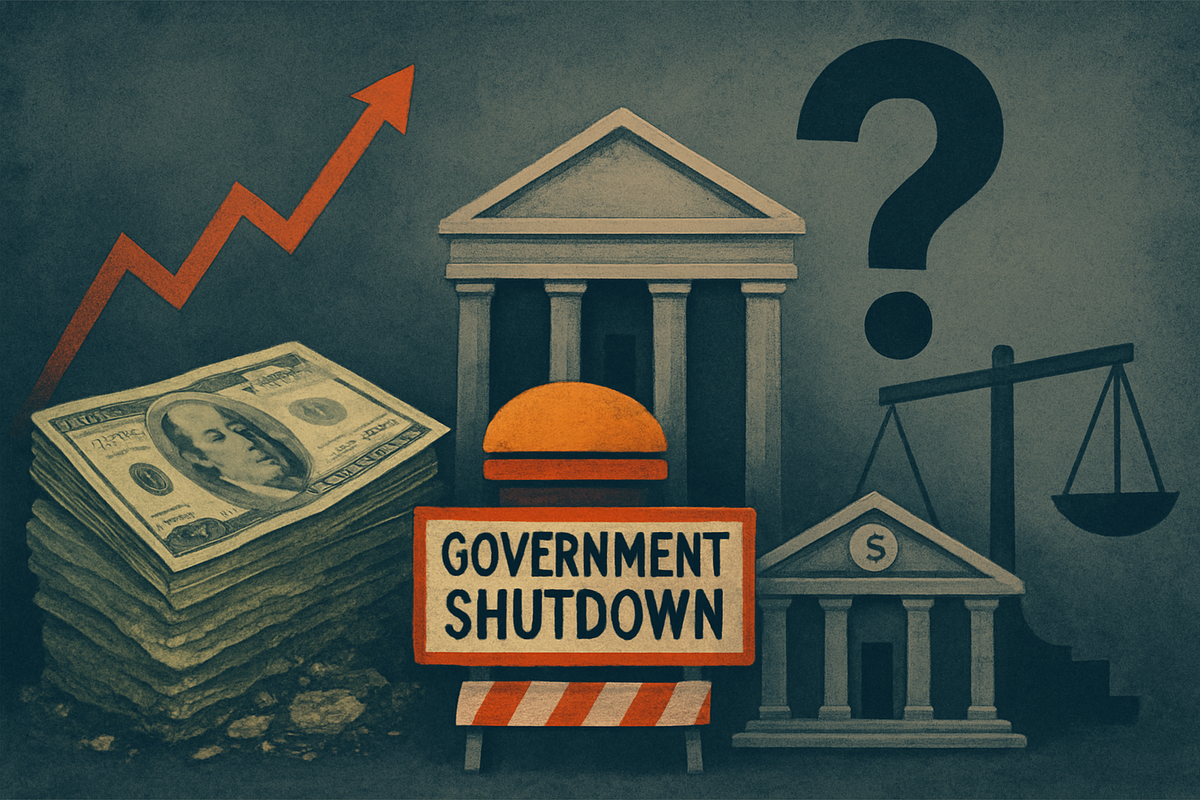
The American economy finds itself at a precarious juncture, grappling with the twin challenges of persistently high inflation and the recent, historically long government shutdown. These formidable headwinds are rapidly eroding market confidence in further Federal Reserve interest rate cuts, injecting a palpable sense of uncertainty into financial markets and the broader economic outlook. What was once seen as a near certainty – continued monetary easing – has now become a "coin toss," as policymakers face a murky economic landscape clouded by incomplete data and divergent views.
This confluence of factors has left investors and businesses alike in a state of heightened apprehension. The Federal Reserve, tasked with balancing price stability and maximum employment, must now navigate an environment where key economic indicators are either delayed or potentially unavailable, making an already complex decision-making process even more arduous. The implications for public companies and the average American are significant, promising a period of sustained volatility and strategic re-evaluation.
A Perfect Storm: Inflation's Grip Tightens as Government Grinds to a Halt
The recent economic narrative has been dominated by two critical developments: the stubborn resilience of inflation and the disruptive force of a prolonged government shutdown. According to the latest available data, the Consumer Price Index (CPI) for All Urban Consumers (CPI-U) increased by 3.0% over the 12 months ending September 2025. The "core" CPI, which excludes volatile food and energy prices, also rose by 3.0% annually, indicating broad-based price pressures. The Federal Reserve's preferred inflation gauge, the Personal Consumption Expenditures (PCE) Price Index, saw an annual increase of 2.74% in August 2025, with the Core PCE Price Index rising by 2.91% annually in the same month. These figures consistently remain above the Federal Reserve's 2% target, signifying that inflationary pressures are proving more "sticky" than initially anticipated.
Compounding this inflationary challenge was the United States' longest government shutdown in history, which spanned 43 days from October 1 to November 12, 2025. This unprecedented closure stemmed from Congress's inability to pass appropriations legislation for the 2026 fiscal year, primarily due to Democratic opposition to a Republican bill that omitted an extension of expanded Affordable Care Act subsidies. Further complicating matters was the Trump administration's directive for federal agencies to consider permanent job cuts during the shutdown. The resolution, signed by President Trump on November 12, 2025, provided temporary funding for most federal operations until January 30, 2026, leaving lingering concerns about future fiscal stability.
The economic fallout from the shutdown was substantial, with the Congressional Budget Office (CBO) estimating a permanent economic loss ranging from $7 billion to $18 billion in the fourth quarter of 2025 alone, contributing to an overall permanent loss of approximately $11 billion. Beyond the direct financial hit, a critical consequence was the disruption and delay of vital economic data releases, including October's CPI, PCE, and employment figures. The White House even suggested that some October labor market and inflation data might never be released, creating a "fog of uncertainty" for policymakers and market participants. Roughly 900,000 federal employees were furloughed, and two million worked without pay, impacting consumer spending, while small businesses reliant on federal funding faced an estimated loss of $371 million per month. Initial market reactions included increased volatility, a potential fall in Treasury yields as investors sought safe havens, and wobbling equity markets, reflecting growing unease about the economic outlook.
The Federal Reserve had already reduced the federal funds rate by 25 basis points at its October 2025 meeting, setting the target range at 3.75%–4.00%, following a similar cut in September. However, the probability of another quarter-point interest rate cut at the upcoming December 9-10, 2025, Federal Open Market Committee (FOMC) meeting has plummeted to approximately 50-53% as of November 13-14, 2025, a dramatic drop from 95% just a month prior. This significant shift underscores the market's dwindling confidence, driven by the persistent inflation above the Fed's 2% target and the profound data uncertainty caused by the government shutdown. Federal Reserve officials themselves appear divided, with Fed Chair Jerome Powell explicitly stating that a December rate cut is "not a foregone conclusion," and Kansas City Fed President Jeff Schmid specifically warning that additional cuts might drive inflation higher. The lack of reliable October data means the Fed will have "less data than usual" for its crucial December decision, further complicating the path forward.
Corporate Fortunes in Flux: Winners and Losers in an Era of Uncertainty
The current economic climate, marked by persistent inflation and the aftermath of a government shutdown, is creating a distinct bifurcation in the corporate landscape, delineating clear winners and losers. Companies with robust pricing power and essential offerings are better positioned to weather the storm, while those reliant on discretionary spending, government contracts, or cheap capital face significant headwinds. The fading prospect of further Federal Reserve rate cuts further exacerbates these dynamics, making borrowing more expensive and dampening consumer and business investment.
In an inflationary environment, Consumer Staples companies tend to demonstrate resilience. Firms like Procter & Gamble Co. (NYSE: PG) or Walmart Inc. (NYSE: WMT), which provide essential goods such as food, beverages, and household products, often possess the pricing power to pass on rising raw material and operational costs to consumers, thereby safeguarding their profit margins. However, even these giants must contend with the possibility of consumers "trading down" to cheaper alternatives or reducing purchase volumes if price increases become too aggressive. Conversely, the Consumer Discretionary sector is particularly vulnerable. Companies selling non-essential goods and services, such as Tesla Inc. (NASDAQ: TSLA) (auto manufacturers), Lowe's Companies Inc. (NYSE: LOW) (home improvement), or luxury retailers, are likely to see reduced sales and demand as consumers' purchasing power diminishes and credit costs rise.
The Technology sector, especially growth-stage companies, also faces significant challenges. Higher inflation drives up operational costs for cloud infrastructure, software licenses, and labor. More critically, the increased cost of capital due to higher interest rates makes it more expensive for these firms to secure funding for expansion, impacting their valuations and growth strategies. Companies with high debt loads, regardless of sector, will find refinancing existing debt more expensive, leading to increased interest expenses and reduced profitability. On the flip side, the Energy sector generally benefits from inflationary pressures. As energy prices are often a primary driver of overall inflation, companies involved in oil, gas, and electricity generation, such as Exxon Mobil Corporation (NYSE: XOM), can frequently pass on increased fuel and operational costs to consumers, bolstering their revenues.
The recent government shutdown has left its own distinct mark on various industries. Defense Contractors like Lockheed Martin Corporation (NYSE: LMT) or Raytheon Technologies Corporation (NYSE: RTX), heavily reliant on government contracts, experienced delays in contract awards, payments, and project approvals. While existing multi-year projects might have continued, new orders were halted, impacting future revenue pipelines. Similarly, Government Service Providers faced immediate revenue loss and potential employee furloughs. The Tourism industry also suffered, with national parks and museums closing, leading to booking cancellations for hotels, airlines, and related services, impacting companies like Marriott International, Inc. (NASDAQ: MAR) or Southwest Airlines Co. (NYSE: LUV). Even the Financial Services sector saw disruptions as regulatory agencies like the SEC and IRS slowed operations, impacting IPOs and other financial transactions.
The diminished likelihood of further rate cuts, or even the prospect of future hikes, will disproportionately affect certain companies. The Real Estate sector is highly sensitive; homebuilders like D.R. Horton, Inc. (NYSE: DHI) will see reduced demand due to higher mortgage rates, while Real Estate Investment Trusts (REITs) and commercial developers face increased borrowing costs for acquisitions and new projects. Technology companies that depend on external financing for growth will find capital more expensive, potentially slowing innovation and expansion. Consumer Discretionary firms selling big-ticket items, such as auto manufacturers, will see demand wane as consumer financing becomes costlier. While Banking institutions might initially benefit from higher net interest margins, a sustained period of high rates increases credit risk across the economy, potentially leading to higher loan defaults and impacting profitability for banks like JPMorgan Chase & Co. (NYSE: JPM). Finally, Utilities, often considered "bond proxies" for their stable dividends, may become less attractive compared to rising bond yields, potentially putting downward pressure on their stock prices.
Wider Significance: A Global Web of Interconnected Risks
The current economic predicament in the United States, characterized by stubborn inflation and the disruptive impact of a government shutdown, extends far beyond domestic borders, weaving into a complex tapestry of global economic slowdowns, persistent supply chain vulnerabilities, and escalating geopolitical tensions. This confluence of factors not only amplifies uncertainty but also poses significant ripple effects on international trade, investment, and the stability of various industry sectors worldwide.
The U.S. experience with inflation is not an isolated incident; rather, it reflects a broader global phenomenon. Central banks across developed economies have been aggressively raising interest rates to combat similar inflationary pressures, leading to a synchronized global economic slowdown. The recent 43-day U.S. government shutdown directly contributed to this global deceleration by reducing U.S. GDP growth, with estimates suggesting a reduction of 0.1 to 0.2 percentage points for each week it continued. This economic loss, potentially billions of dollars, is not fully recoverable and creates a lasting drag that reverberates through interconnected global markets. Moreover, the shutdown directly impeded the efficiency of global supply chains, causing backlogs in cargo inspection, slowed import documentation, and delays in federal procurement, disrupting not only U.S. businesses but also their international partners.
The ripple effects are profound and multifaceted. High inflation in the U.S. influences the value of the dollar, impacting trade balances; a stronger dollar, a potential outcome of higher interest rates, might attract foreign capital but could make U.S. exports less competitive. The uncertainty generated by a government shutdown can shake confidence in global supply chain planning, cause commodity prices to swing, and increase freight rates as companies scramble to mitigate delays. Businesses heavily reliant on federal contracts, from small enterprises to large Defense Contractors, face severe disruptions and cash flow issues. Regulated industries, such as alcohol producers requiring federal licenses or companies needing U.S. Securities and Exchange Commission (SEC) approval for registrations, experience significant delays, hindering operations and market entry. The Transportation and Travel sectors suffer from flight cancellations and delays due to staffing shortages at federal agencies, while global manufacturers and exporters anxiously watch U.S. administrative disruptions that can threaten their ability to meet customer deadlines.
The regulatory and policy implications of this environment are substantial. For the Federal Reserve, the government shutdown critically impaired its ability to make informed decisions by delaying the release of essential economic data. Operating in a "fog of uncertainty," the Fed is forced to adopt a more cautious, "higher-for-longer" interest rate stance to re-anchor inflation expectations, potentially delaying rate cuts further into the future. From a fiscal policy perspective, Congress and the President are pressured to implement measures that temper demand and boost supply, such as reducing government spending, increasing taxes, or implementing supply-side reforms. However, a prolonged period of fiscal instability, as demonstrated by the shutdown, erodes confidence in the government's financial management and its ability to control inflation expectations, potentially damaging the federal statistical system itself. The broader regulatory environment also suffers, with agencies like the SEC and Commodity Futures Trading Commission (CFTC) operating with limited staff, leading to backlogs in reviews, enforcement actions, and the publication of new rules, creating widespread uncertainty for businesses.
Historically, the U.S. has weathered numerous government shutdowns, with notable events including the 16-day shutdown in 2013 and the 35-day shutdown in 2018-2019, culminating in the recent 43-day closure. These precedents consistently demonstrate negative economic impacts, including reduced GDP growth and permanent economic losses, alongside the recurring challenge of delayed economic data. For the central bank's dilemma with stubborn inflation amidst instability, the "Great Inflation" of the 1970s serves as a stark historical parallel. During that era, the Federal Reserve under Chairman Paul Volcker had to implement aggressive monetary policy tightening to re-anchor inflation expectations, albeit at the cost of a significant economic downturn. This historical context underscores the difficult trade-offs central banks face between managing inflation and supporting employment, particularly when compounded by fiscal instability, emphasizing the critical importance of a sustained commitment to price stability to prevent inflation expectations from becoming unanchored.
What Comes Next: Navigating a Shifting Economic Tide
The path forward for the American economy is fraught with both challenges and potential opportunities, dictated by the interplay of inflation, monetary policy, and fiscal stability. In the short term, inflation is expected to remain elevated, with the U.S. annual inflation rate increasing to 3% in September 2025 and projected to reach 3.1% by the end of the current quarter. This uptick is primarily attributed to higher food prices, tariffs, and a slower-than-expected easing in service-sector inflation. However, looking further out, the U.S. Inflation Rate is projected to trend downward to around 2.6% in 2026 and 2.4% in 2027, as economists anticipate softening economic growth to eventually push the Federal Reserve to lower rates.
Regarding interest rates, the Federal Reserve has already initiated cuts, bringing the benchmark rate to a target range of 3.75%-4.00% after reductions in September and October 2025. Despite the recent uncertainty, a high probability of another quarter-point cut persists for December 2025. Most analysts, including J.P. Morgan and Goldman Sachs Research, foresee continued rate cuts into 2026, with projections placing the federal funds rate between 3.5% and 4.0% by the end of 2025, and further declining to 3.25% in 2027. Morningstar even projects the rate could reach 2.25%-2.50% by the end of 2027. These "risk management cuts" aim to prevent further slowing of the labor market. However, a "hawkish hold" scenario remains plausible if inflation proves more persistent, leading to a delayed soft landing where growth decelerates without a severe recession, but with rates held steady for longer. The impact of future government instability, such as further shutdowns, could delay crucial economic data, adding layers of uncertainty to the Fed's decision-making process.
For investors, this environment presents both significant challenges and emerging opportunities. High inflation continues to erode the value of cash and traditional fixed-income investments, while market volatility remains a persistent concern. Higher borrowing costs for companies, particularly for small businesses and startups, could squeeze profit margins and reduce valuations. Reduced consumer spending due to higher interest rates on mortgages and credit cards will also impact discretionary sectors. However, opportunities exist for strategic investors. Diversification across asset classes remains paramount. Inflation-indexed securities like Treasury Inflation-Protected Securities (TIPS) and I Bonds offer direct protection. Real Estate Investment Trusts (REITs) and Commodities, especially gold and energy, tend to perform well during inflationary periods. Companies like Barrick Gold Corporation (NYSE: GOLD) and Newmont Corporation (NYSE: NEM) could benefit from safe-haven demand. Furthermore, leaning into equities, particularly value stocks, dividend-paying stocks, and companies with strong fundamentals, can be advantageous over the long term, as stocks have historically outpaced inflation. High-yield savings accounts and short-term bonds also become more attractive for managing liquidity.
Public companies, in turn, must execute strategic pivots to adapt. Strengthening financial resilience through optimized cash flow, reduced debt exposure, and robust cash reserves is critical to lessen reliance on external borrowing. Aggressive cost management and operational efficiency, including investments in automation and AI, will be essential to withstand inflationary shocks. Dynamic pricing strategies will be necessary to maintain profit margins. Companies must also prioritize supply chain resilience by diversifying and investing in local sourcing to mitigate disruptions and reduce exposure to volatile global markets. Re-evaluating growth and expansion plans, focusing on projects with higher and quicker returns, and enhancing forecasting methods with scenario modeling will be crucial. Lastly, in an environment of reduced consumer spending, a strong emphasis on customer retention and diversifying financing options beyond traditional bank loans will be key for survival and growth.
Looking ahead, several potential outcomes for the American economy are being considered. A "soft landing," where inflation moderates without a severe recession, remains a base case for many, with a mild slowdown in 2025 followed by recovery. However, a "challenging soft landing," with elevated odds of a moderate recession, is also a significant possibility. Other scenarios include a "no landing, but higher productivity," where regulatory reforms drive growth despite persistent inflation, or the more concerning "stagflation," characterized by high inflation coexisting with sluggish growth and rising unemployment. A "hard landing" or recession, triggered by overly restrictive Fed policy or unforeseen shocks, remains a possibility, as do the disruptive effects of renewed "trade wars" with aggressive tariffs. Finally, the specter of continued government instability, including future shutdowns, poses a constant threat of significant economic costs, permanent GDP loss, and a persistent hit to economic confidence. The American economy in late 2025 and into 2026 demands adaptability, diversification, and a sharp focus on resilience from all stakeholders.
Comprehensive Wrap-up: Navigating the New Normal of Economic Volatility
The American economy stands at a critical juncture, buffeted by the enduring challenges of stubborn inflation and the recent disruptive government shutdown. This intricate interplay has significantly eroded market confidence in further Federal Reserve interest rate cuts, ushering in a period of heightened uncertainty and demanding a new level of adaptability from businesses, policymakers, and investors alike. The key takeaway is that the era of predictable economic cycles and monetary policy responses may be giving way to a more volatile and less certain "new normal."
Moving forward, the market will be closely watching a few pivotal indicators. The Federal Reserve's actions at its upcoming December 9-10, 2025, FOMC meeting will be paramount, as the probability of another rate cut hangs in the balance. Any divergence in rhetoric from Fed officials, or shifts in their "dot plot" projections for future rates, will send strong signals. Crucially, the return of reliable economic data, particularly October's delayed CPI, PCE, and employment figures, will be vital for the Fed to make informed decisions. Beyond monetary policy, investor attention will also be fixed on legislative developments in Washington. The temporary nature of the recent budget agreement means that the risk of future government shutdowns or fiscal impasses remains, threatening to reintroduce economic uncertainty and potentially undermine consumer and business confidence.
The lasting impact of this period will likely be a reinforced emphasis on resilience and strategic flexibility across all sectors. Public companies will need to prioritize robust balance sheets, diversified supply chains, and agile pricing strategies to navigate persistent cost pressures and potential demand fluctuations. For investors, the focus will shift from purely growth-driven strategies to a more balanced approach, incorporating inflation hedges, value stocks, and sectors less sensitive to interest rate volatility. The experiences of 2025 serve as a stark reminder that economic stability is not a given, and preparedness for a range of scenarios—from a challenging soft landing to potential stagflation—is now an imperative. The coming months will test the resolve and adaptability of the American economy, requiring careful navigation through these turbulent crosscurrents.
This content is intended for informational purposes only and is not financial advice






